Prime Minister Shehbaz Sharif has lauded Pakistan’s progress toward economic stability and diplomatic success, attributing it to effective governance, hard work, and a shared national vision.
Speaking to the media in Jahanian, Punjab, the…

Prime Minister Shehbaz Sharif has lauded Pakistan’s progress toward economic stability and diplomatic success, attributing it to effective governance, hard work, and a shared national vision.
Speaking to the media in Jahanian, Punjab, the…

Six-time champions Argentina will take on Morocco in the FIFA U-20 World Cup 2025 final at Chile’s Estadio Nacional Julio Martínez Prádanos in the early hours of Monday morning.
The Argentina vs Morocco FIFA U-20 World Cup 2025 final will be…
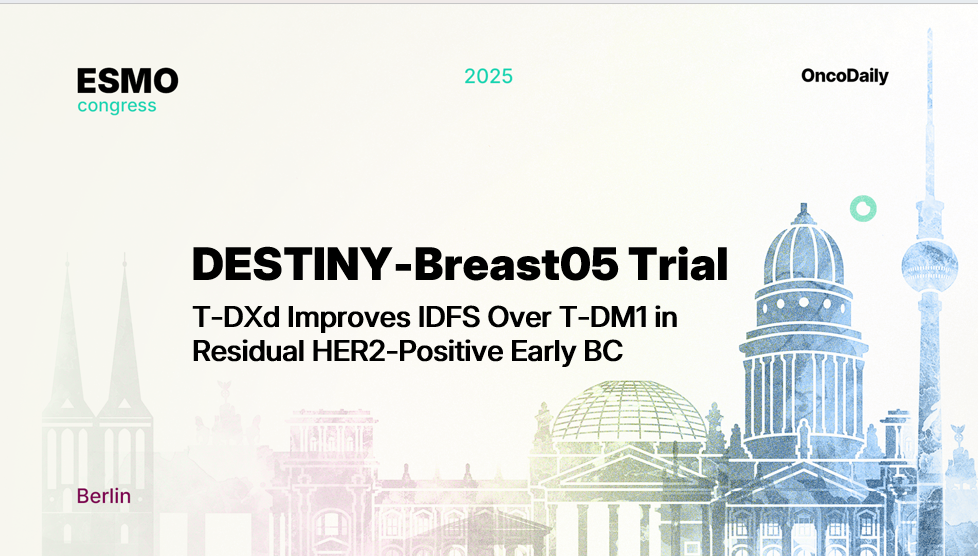
DESTINY-Breast05 (NCT04622319), presented by Dr. Charles E. Geyer (Pittsburgh, United States of America) at the ESMO Congress 2025, is a pivotal phase 3, open-label, randomized trial evaluating trastuzumab deruxtecan (T-DXd) versus the standard-of-care trastuzumab emtansine (T-DM1) in patients with HER2-positive early breast cancer (eBC) who had residual invasive disease after neoadjuvant therapy. The study was designed to determine whether T-DXd could improve long-term outcomes for this high-risk population compared with T-DM1, the established post-neoadjuvant standard of care
Patients with HER2-positive early breast cancer who have residual invasive disease following neoadjuvant chemotherapy and anti-HER2 therapy face a high risk of recurrence, particularly distant relapse. T-DM1 became the standard post-neoadjuvant treatment following the KATHERINE trial, but outcomes remain suboptimal for patients with high residual disease burden. Trastuzumab deruxtecan (T-DXd), a next-generation HER2-directed antibody–drug conjugate with a potent topoisomerase I inhibitor payload, has shown marked efficacy in metastatic settings, prompting investigation into its use in the early disease setting to reduce recurrence risk.
In DESTINY-Breast05, 1,635 patients with HER2-positive eBC and residual invasive disease after neoadjuvant taxane-based chemotherapy and HER2-targeted therapy were randomized 1:1 to receive either:
Eligible patients were considered high risk for recurrence, defined by clinical stages T4, N0–3, M0 or T1–3, N2–3, M0 at presentation, or residual nodal disease after neoadjuvant therapy.
The primary endpoint was invasive disease-free survival (IDFS), with disease-free survival (DFS) as a key secondary endpoint. Additional endpoints included overall survival (OS), distant recurrence-free interval, brain metastasis–free interval (BMFI), and safety.
At the data cutoff of July 2, 2025, median follow-up was 29.9 months in the T-DXd arm and 29.7 months in the T-DM1 arm.
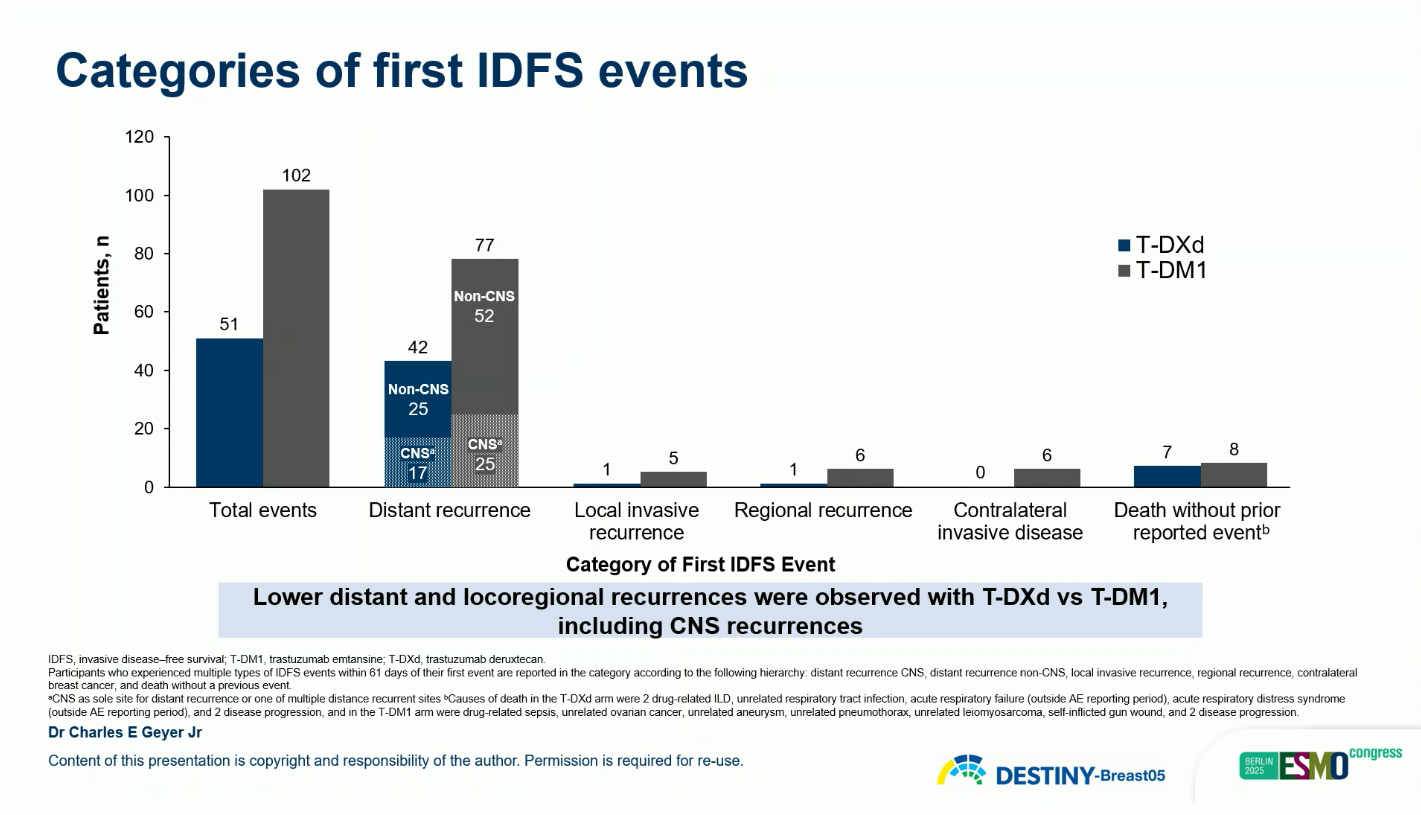
Similarly, the key secondary endpoint of disease-free survival (DFS) demonstrated a parallel benefit, with a hazard ratio of 0.47 (95% CI, 0.34–0.66; p < 0.0001). The 3-year DFS rate was 92.3% with T-DXd compared with 83.5% with T-DM1, corresponding to an 8.8% absolute gain.
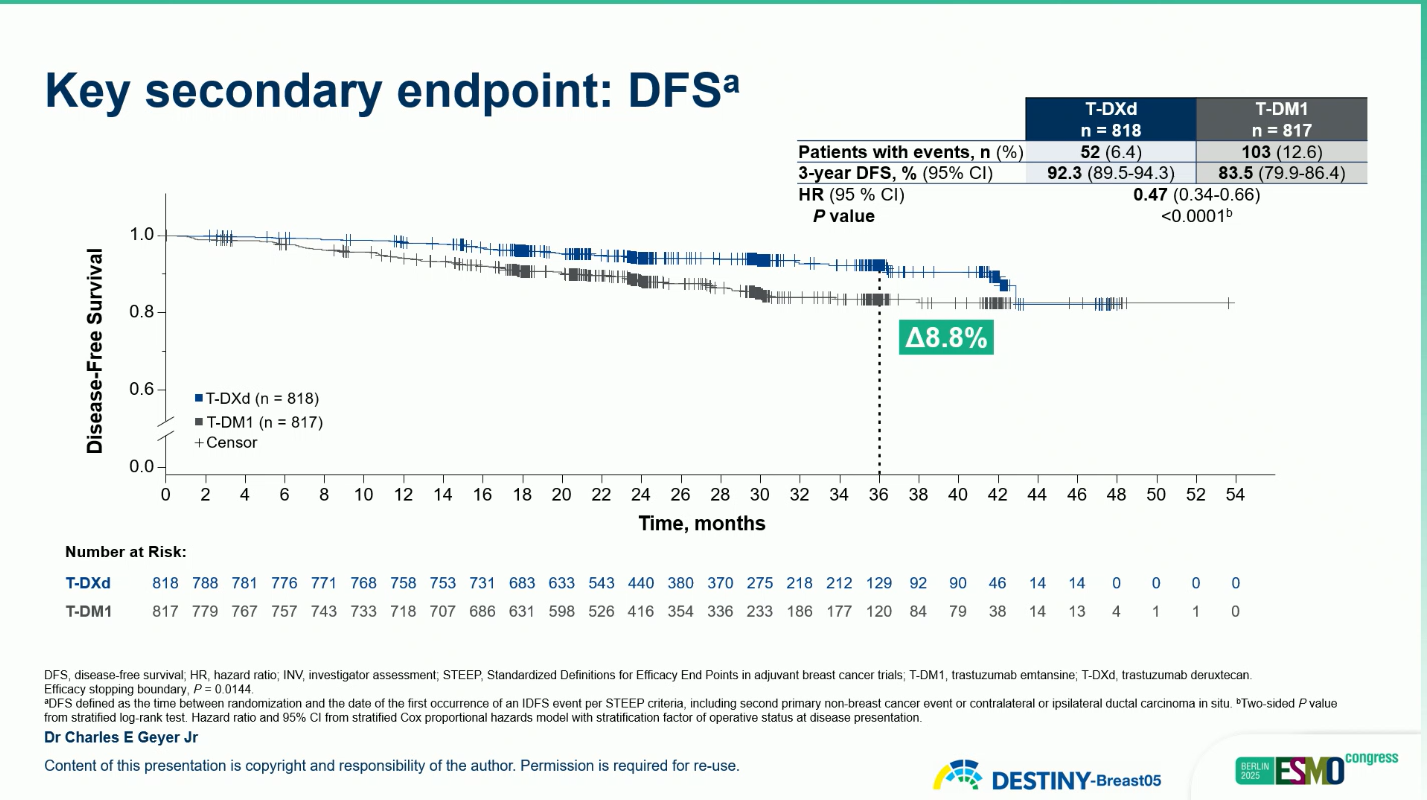
These findings represent a 53% reduction in risk of invasive disease recurrence or death with T-DXd compared with T-DM1.
A clinically meaningful improvement in BMFI was also observed (HR 0.64; 95% CI 0.35–1.17), suggesting enhanced control of central nervous system relapse.
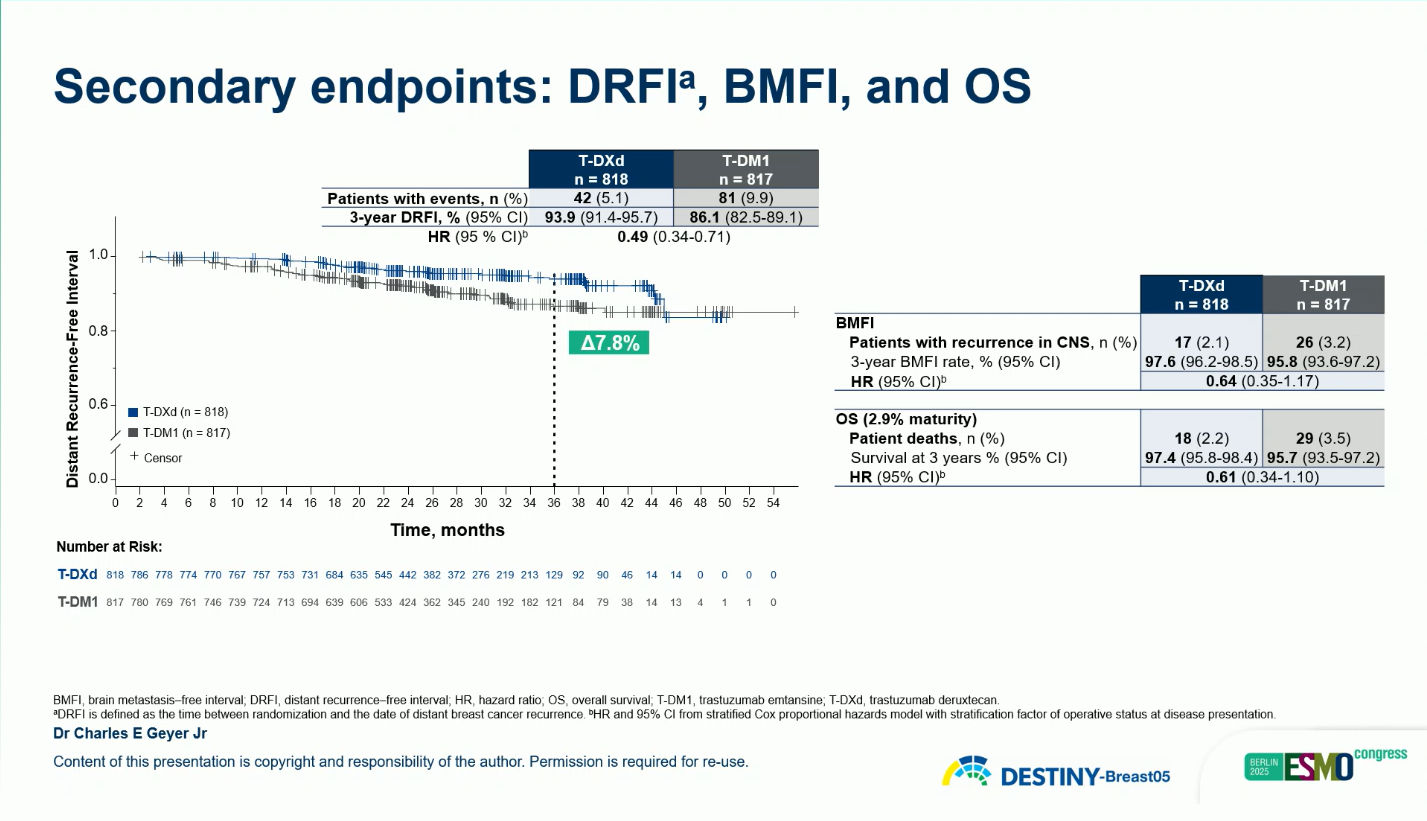
The overall safety profile of T-DXd was manageable and consistent with prior studies.
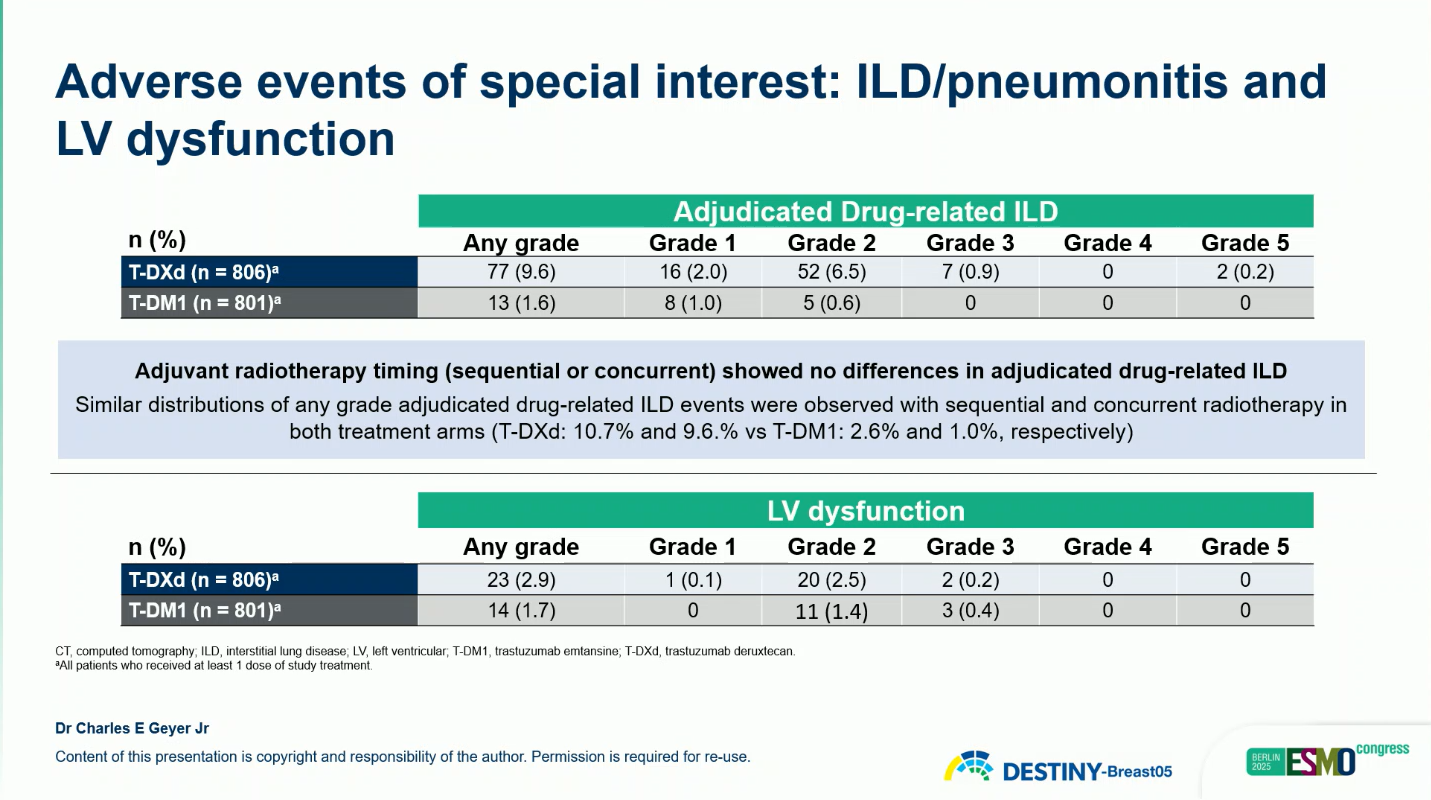
Most ILD events were grade 1–2 and resolved with treatment modification or corticosteroids. No new safety signals were identified.
The DESTINY-Breast05 trial demonstrated that trastuzumab deruxtecan (T-DXd) offers a statistically significant and clinically meaningful improvement in both invasive disease-free survival (IDFS) and disease-free survival (DFS) compared with trastuzumab emtansine (T-DM1) in patients with HER2-positive early breast cancer who had residual invasive disease following neoadjuvant therapy.
These findings mark a pivotal advance in the post-neoadjuvant management of HER2-positive breast cancer. By extending the proven efficacy of T-DXd beyond the metastatic setting into early-stage, high-risk disease, the results highlight its potential to redefine the standard of care for patients who previously had limited options after incomplete response to neoadjuvant therapy. Importantly, the benefit was consistent across all major subgroups, including hormone receptor–positive and –negative disease, as well as across regions and baseline disease characteristics, underscoring the robustness of the findings.
You can read the full abstract here.

Watch a room of 70-somethings when “Mrs. Robinson” starts. Shoulders straighten, eyes soften, lips move to words unvisited for decades. For three minutes and thirty seconds, mortgages and medications vanish. They’re nineteen again,…

San Diego, CA. October 17, 2025. Posing for the AI Camera at Twitch Con.
Charlie Fink
At TwitchCon San Diego, the Israeli startup Decart staged a live demonstration of something I’ve not seen before: real-time generative AI video. Partnering…

Final analysis from the
revealed that 177-Lu-edotretide (ITM-11) vs everolimus met its primary and secondary endpoints in patients with gastroenteropancreatic neuroendocrine tumors (GEP-NETs).The final analysis was announced at the 2025 European Association of Nuclear Medicine Annual CongressSociety for Medical Oncology (ESMO) Congress on October 18, 2025.21 The results were presented by Jaume Capdevila, MD, PhD, Vall d’Hebron University Hospital.
The primary endpoint was progression-free survival (PFS), which was reached with statistically significant and clinically meaningful improvement. The median PFS was significantly longer in patients who tookadministered ITM-11 compared to those who tookadministered everolimus. The secondary endpoint of the trial was overall survival (OS), which was also identified to be higher in patients who tookwere administered ITM-11 vs everolimus.2
There was a total of 207 patients in the ITM-11 group and 102 patients in the everolimus group. , respectively. The median ages of both groups were 65 (ITM-11), and 61 (everolimus). Majority of patients in both groups were male. The majority of patients had grade 2, non-functional GEP-NETs and had received prior therapy.1,2
COMPETE met its primary endpoint of PFS, which proved to be significantly longer in patients treated with ITM-11 vs everolimus. The central assessment was 23.9 vs 14.1 months (HR, 0.67; 95% CI, 0.48–0.95; P=.022).; HR .67, 95% CI [.48, .95]). The local assessment was 24.1 vs 17.6 months (P=.010; HR, 0.66; 95% CI, 0 [.48–0, .91] P =.010;).2
In the subgroup analysis of PFS by tumor origin, mPFS was found to be numerically longer in GE-NETs and P-NETs in the ITM-11 arm. In GE-NETs the mPFS was 23.9 vs 12 months (P=.090; HR 0.64, 95% CI, 0i [.38–, 1.08;] P=.090;). In P-NETs the mPFS was 24.5 vs 14.7 months (HR, 0.70, P=.114; HR .70, 95% CI, 0 [.45–, 1.09; P=.114;]).2
It was also identified that mPFS was numerically longer in grade 1 and significantly longer in grade 2 tumors in the ITM-11 arm. Grade 1 was 30 vs 23.7 months (P=.753; HR, 0.89, 95% CI, 0. [.42–, 1.8; 7]P =.753;), and grade 2 was 21.7 vs 9.2 months (P=.0003; HR 0.55l , 95% CI, 0i [.37–0, .82] P =.0003).2
In exploring PFS by prior therapy, it was identified that mPFS was numerically longer in the first line and significantly longer in the second line in the ITM-11 arm. First line data showed the mPFS was not reached in the ITM-11NR vs 18.1 months (P=.249; HR, 0.60, 95% CI, 0 [.25–, 1.45; P =.249]), and second line data showed 23.9 vs 14.1 months (P=.039; HR, 0.68; , 95% CI, 0 [.47–0,, 98] P=.039).2
Overall response rates (ORR), one of the secondary endpoints of the trial, was found to be significantly higher in the ITM-11 arm. Central assessment was 21.9% vs 4.2% (P<.0001), and local assessment was 30.5% vs 8.4% (P<.0001).2
Adverse events (AEs) related to the drug study were experienced by 82% of patients ITM-11 group, and 97% of patients in the everolimus group. The most common AEs reported were nausea (30% vs 10.1%), diarrhea (14.3% vs 35.4%), asthenia (25.3% vs 31.3%), and fatigue (15.7% vs 15.2%). These AEs were expected based on the known safety profile of ITM-11.2
AEs leading to premature study discontinuation wereas 1.8% vs 15.2% among both groups, respectively, dose modification or discontinuation wereas 3.7% vs 52.5%, among both groups, and the amount of patients with delayed study drug administration due to toxicity was 0.9% in the ITM-11 group, and none 0% in the everolimus group.2
Dosimetry data showed targeted tumor uptake with low exposure to healthy organs, with normal organ absorbed doses well below safety thresholds.
Patient inclusion criteria included being 18 or older, having well-differentiated, non-functional GE-NET or functional/non-functional P-NET;, grade 1/2 unresectable or metastatic, progressive, SSRT-positive+ disease; and , being treatment-naive to first-line therapies or progressing , or progressed under prior second-line therapies.1,2
Morphologic imagining was conducted in 3-month intervals. The PFS follow-up was done every 3 months after the first 30 days. Long-term follow-up was done every 6 months.
“With these data combining extensive dosimetry information from more than 200 patients included in a prospective trial, ITM is laying the groundwork for improved therapeutic decision-making by providing important insights into tumor uptake and treatment variability,” Emmanuel Deshayes, MD, PhD, professor in biophysics and nuclear medicine at the Montpellier Cancer Institute in France, said in a news release.2 “It may offer clinically meaningful implications for optimizing individualized patient management.”
Dosimetry data from COMPETE shaped the design of ITM’s phase 3 COMPOSE (NCT04919226)4 trial, with ITM-11 in well-differentiated, aggressive grade 2 or grade 3 SSTR-positive+ GEP-NET tumors, as well as the upcoming phase 1 pediatric KinLET (NCT06441331) study in SSTR-positive+ tumors.
DISCLOSURES: Capdevila noted grants and/or research support from Advanced Accelerator Applications, AstraZeneca, Amgen, Bayer, Eisai, Gilead, ITM, Novartis, Pfizer, and Roche; participation as a speaker, consultant, or advisor for Advanced Acclerator Applications, Advanz Pharma, Amgen, Bayer, Eisai, Esteve, Exelixis, Hutchmed, Ipsen, ITM, Lilly, Merck Serono, Novartis, Pfizer, Roche, and Sanofi; position as advisory board member for Amgen, Bayer, Eisai, Esteve, Exelixis, Ipsen, ITM, Lilly, Novartis, and Roche; and a leadership role and chair position for the Spanish Task Force for Neuroendocrine and Endocrine Tumours Group (GETNE).
A model and actress’ family has been awarded a hefty sum after she ate a pretzel which left her with brain damage.
Chantel Giacalone was known for her roles in The Butterfly Effect 3, Hollow Walls, and Skyler before a tragedy struck her and her…
LONDON, Oct. 18 (Xinhua) — During the fourth London International Screen Dance Festival held from Thursday to Friday at the Trinity Laban Conservatoire of Music and Dance in London, Chinese entries attracted great attention among…